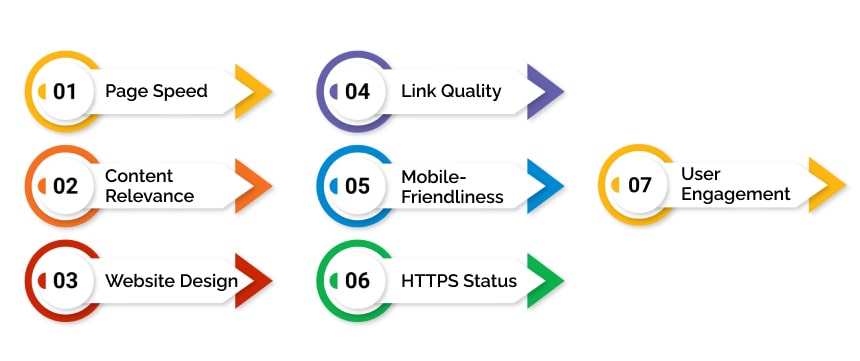
Google Search Tricks: The Definitive Guide to Mastering the Google Algorithm
Keeping pace with Google's ever-evolving ranking algorithm is a challenging task for website owners and digital marketers. However, armed with knowledge and strategic insights, staying ahead becomes not just a possibility but a strategic advantage. In this guide, we'll explore a timeline of crucial Google algorithm updates, dissect their impact, and equip you with effective Google search hacks to optimize your rankings in the face of future updates.
Understanding Google Algorithm's Ranking Factors
Let's begin by exploring what we understand about Google's algorithm and the elements that influence its rankings.
The reality is, we don't know a whole lot. This is because Google doesn't disclose its most important ranking factors. In simpler terms, nobody is entirely certain about the specific things needed to rank well. Nevertheless, here's a summary of the ranking factors that are known:

-
Page Speed: A website's swift loading not only improves user satisfaction but also boosts its rankings on Google, highlighting the importance of efficient performance.
-
Content Relevance: Striking the right balance between incorporating relevant keywords and delivering high-quality content is paramount for Google, ensuring a website's visibility and credibility.
-
Website Design: Google values a user-friendly website design with easy navigation, recognizing the significance of a positive user experience in determining rankings.
-
Link Quality: Google places great importance on high-quality backlinks from authoritative websites, considering them as a significant factor in determining a site's credibility and relevance.
-
Mobile-Friendliness: With Google's mobile-first approach, the optimization of websites for mobile devices is crucial for maintaining and improving search rankings.
-
HTTPS Status: Google prefers secure websites denoted by HTTPS, as they are considered more trustworthy, highlighting the significance of implementing SSL certificates for ranking benefits.
-
User Engagement: A high bounce rate, indicative of a poor user experience, can result in penalties from Google, underscoring the critical role of user engagement in maintaining favorable rankings
How Search Engines Crawl, Index and Rank?

Search engines follow a systematic process known as crawling, indexing, and ranking to organize and present information to users effectively. Initially, search engine bots engage in crawling, exploring the web by following links and discovering new content. Once a page is crawled, it undergoes indexing, during which the search engine analyzes various elements like keywords and meta tags to create a structured database. The final step involves ranking, where algorithms assess the relevance of indexed pages to specific search queries, considering factors such as content quality, backlinks, and user experience.
Crawling
-
Search engine bots navigate the internet by following links.
-
The crawling process discovers new and updated content on webpages.
Indexing
-
Pages crawled are indexed, creating a structured database.
-
Algorithms analyze elements like keywords and meta tags during indexing.
Ranking
-
Search engines evaluate the relevance of indexed pages to specific queries.
-
Factors such as content quality, backlinks, and user experience impact ranking.
How Often Are Google Algorithm Changes Released?
Google introduces minor algorithm changes daily, often going unnoticed. However, "core" updates, which are larger and more impactful, occur a few times a year. Keeping an eye on these core updates is crucial, as they can directly affect your website's performance
Key Google Algorithm Updates and Their Impact
To help you better understand Google algorithm updates, here are some key historical updates and their impact on ranking strategies.
Search Generative Experience (SGE)
-
SGE represents a fundamental shift in Google's search approach, utilizing generative AI to provide detailed responses and facilitate follow-up queries.
-
It offers users links to relevant resources and guides them through subsequent steps, such as booking tickets or visiting online stores.
-
Currently, SGE is available exclusively in the U.S., requiring users to opt-in for access.
How-To and FAQ Changes (August and September, 2023)
-
Changes in displaying rich search results, reducing FAQ visibility, and eliminating How-To results on desktop after September 13.
-
FAQ results are now sourced from authoritative government and health websites.
-
Websites need not remove existing structured data highlighting FAQs and How-Tos, as it won't impact their rankings.
Product Review Update (April 2023)
-
Focuses on enhancing user experience and adheres to E-E-A-T guidelines.
-
Prioritizes informative product reviews with original visuals, audio, evidence of product use, and quantitative measurements.
-
Google's ranking algorithm rewards high-quality product reviews in search results.
Link Spam Update (October 19-21, 2022)
-
Targets websites engaged in buying and selling links, utilizing the AI-powered spam detection tool, SpamBrain.
-
Nullifies benefits associated with purchased links; no manual disavowal of spammy links is required.
-
Emphasizes the importance of maintaining a clean link profile using white hat techniques.
Helpful Content Update (August 2022)
-
A new ranking algorithm update rewarding websites producing high-quality, user-friendly content.
-
Focuses on ensuring top search results are filled with helpful and informative content.
-
Initially targeted English pages and later expanded globally to pages in all languages.
Google RankBrain (2015)
-
An extension of the Hummingbird algorithm, RankBrain ranks pages based on their relevance to user search intent.
-
Emphasizes researching user intent behind keywords and creating rich, quality content.
Google Hummingbird (2013)
-
Focuses on bridging the gap between user keywords and desired content, humanizing the search engine experience.
-
Marketers adapt by including more keyword variations and relevant search phrases.
Google Penguin (2012)
-
Combats "black hat" SEO tactics like link directories and spammy backlinks, shifting focus from link volume to high-quality content.
-
Addresses issues such as keyword stuffing for improved search rankings.
Google Panda (2011)
-
Targets bad practices like keyword stuffing and duplicate content, introducing a "quality score" for ranking pages.
-
Encourages marketers to create educational, quality content, rewrite underperforming articles, and use keywords strategically for survival.
Detecting and Responding to Algorithm Changes
Knowing when Google releases a new algorithm update is crucial for adapting your SEO strategy promptly. Utilizing tools like Google Alerts, monitoring Google SearchLiaison on social media, and employing analytics tools like Google Analytics, MozCast, or Google Grump can keep you informed about any changes that may impact your website.
Recovering from Algorithm Updates
If your website experiences a drop in rankings due to an algorithm update, taking a systematic approach can aid recovery. Conducting a thorough audit, focusing on high-quality content creation, enhancing website performance, building a strong backlink profile, and staying updated with SEO best practices are vital steps.
Google Algorithm vs. Other Search Engines

Google's algorithm differs from other search engines like Bing or Yahoo. Unlike Bing or Yahoo, where the frequency of algorithm updates remains unclear, Google consistently updates its algorithm at a high rate.
Moreover, Bing provides a bit more insight into its primary ranking factors, encompassing metadata, page loading time, and the quantity and quality of backlinks. This transparency makes it somewhat more accessible to comprehend the Bing SEO algorithm, allowing for strategic adjustments.
Yahoo, closely aligned with Bing, follows similar principles, but the distinction lies in their commitment to transparency. Yahoo has published a helpful guide, aiding marketers in gaining a clearer understanding of their search engine algorithm and essential ranking factors.
Understanding Google's Unique Algorithm and Strategies for Success

Google's algorithm differs from other search engines, with its frequency of updates and transparency. While Bing and Yahoo share similarities, understanding their algorithms is more straightforward. Succeeding with Google's algorithm involves adhering to best practices:
-
Optimize for Mobile: To secure a favorable position in Google's rankings, it's crucial to optimize your website for mobile devices due to Google's mobile-first index. Use tools like SmallSEOTools' Mobile-Friendly Test by entering your URL to assess and enhance your site's mobile appearance.
-
Audit Internal Links: Ensure the functionality and relevance of your internal links by fixing broken ones and redirecting them to up-to-date content. Quality internal links can positively impact your rankings and enhance the overall user experience on your site.
-
Boost User Engagement: Prioritize user engagement by aligning your content with proper keyword research to meet search intent. Provide trustworthy and informative content to decrease bounce rates and improve your standing in the Google algorithm.
-
Decrease Site Load Time: A slow-loading website can harm user experience and Google rankings. Use Google's PageSpeed Insights tool to evaluate your page loading times and receive recommendations for improvement.
-
Avoid Duplicate Content: Detect and rectify duplicate content on your site using tools like Duplicate Page Finder. Additionally, check for content duplication on external sites through services like Siteliner to maintain originality.
-
Create Informative Content: Craft valuable and informative content that addresses user queries, promoting longer stays on your site and earning higher rankings from Google.
-
Avoid Keyword Stuffing: Steer clear of keyword stuffing, a practice that involves excessively repeating keywords in your content. Maintain readability by incorporating keywords naturally to stay in line with Google's guidelines.
-
Don't Over-Optimize: Exercise caution in SEO practices, avoiding irrelevant links, purchased links, and over-optimization of anchor text. Strive for a balance between effective SEO and avoiding black hat tactics.
-
Improve Site Navigation: Enhance user experience by streamlining website menus, creating a site map, and ensuring all navigation links are functional.
-
Increase Page Security: Transition to HTTPS for a more secure website, signified by an SSL certificate. Google rewards secure sites with higher rankings, making the move worthwhile for your marketing strategy.
-
Update Old Content: Regularly update and refresh old content to align with Google's evolving algorithm. Add new information, correct errors, and ensure relevance to attract and retain visitors.
-
Monitor Metrics Frequently: Keep a close eye on website metrics to detect any sudden changes, which may indicate the impact of a recent SEO algorithm update.
-
Use External Trackers: Stay informed about the latest Google search changes by utilizing external resources such as Neil Patel's blog, Moz Update History, and Semrush Sensor to track updates and predict trends.
Conclusion:
Adapting to Google's algorithm updates is not just a defensive strategy; it's an opportunity to optimize and enhance your website's performance continually. Stay informed, implement best practices, and navigate the dynamic world of search engine optimization with confidence. As Google's algorithm evolves, so can your strategies, ensuring your online presence remains resilient and successful.




